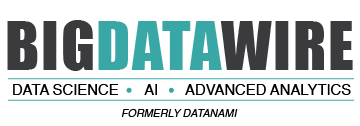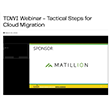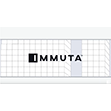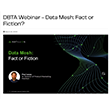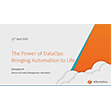

via Shutterstock
Amazon Web Services used a big data conference in the backyard of some of its largest government customers to showcase its AI and machine learning tools that are helping to funnel ever-larger volumes of data into its storage and computing infrastructure.
Making a pitch for better data management tools like metadata systems, AWS executives addressing a big data conference in Tysons Corner, Va., said the the public cloud giant aims to go beyond democratizing big data to “demystify” AI and machine learning.
The combination of organized data and analytics will accelerate the building and deployment of machine learning models, many that currently never make it to production. Those that are deployed often require up to 18 months to roll out, noted Ben Snively, a solution architect at AWS (NASDAQ: AMZN).
Open source tools for model development often advance a generation or two in the time it takes many enterprises to develop, train and launch a machine learning model, he added.
Snively asserted that the combination of big data and analytics along with AI and machine learning creates a “flywheel effect” in which organized, accessible data leads to faster insights, better products and—completing the cycle—more data.
(Hence, the cloud vendor forecasts as much as 180 zettabytes of widely varied and fast-moving data by 2025.)
As it seeks to demystify machine automation technologies and move beyond the current technology “hype phase,” AWS executives note that deployment of machine learning models and, eventually, full-blown platforms, remains hard. Among the reasons are “dirty” data that must be cleansed to foster access. The company estimates that 80 percent of data lakes currently lack metadata management systems that help determine data sources, formats and other attributes needed to wrangle big data.
That makes the heavy investments in data lakes “inefficient,” stressed Alan Halamachi, a senior manager for AWS solution architectures. “If data is not in a format where it can be widely consumed and accessible,” Halamachi stressed, machine learning developers will find themselves in “data jail.”
Once big data is wrangled and secured—“Hackers would like nothing more than to engineer a single breach with access to all of it,” Hamachi said—it can be combined with analytics on the inference side to accelerate training of machine learning models, Snively said.
Noting that most machine learning models built by enterprises never make it to production, the AWS engineers pitched several new tools including its SageMaker machine and deep learning stack introduced in November. Described as a tool for taking the “muck” out of developing machine learning models, Snively said Sagemaker is also designed to free data scientists from IT chores like standing up a server for model development.
The cloud giant is seeing more experimentation among its customers as they seek to connect big data with machine learning development. “Voice [recognition] systems are here to stay,” Snively asserted, and developers are investigating “new ways of interacting with those systems.”
“It’s really about demystifying AI and machine learning” and getting beyond the “magic box” phase, he added.
Recent items:
AWS Takes the ‘Muck’ Out of ML with Sagemaker
How to Make Deep Learning Easy
February 14, 2025
- Clarifai Unveils Control Center for Enhanced AI Visibility and Decision-Making
- EDB Strengthens Partner Program to Accelerate Postgres and AI Adoption Worldwide
- Workday Introduces Agent System of Record for AI Workforce Management
- Fujitsu Unveils Generative AI Cloud Platform with Data Security Focus
- NTT DATA Highlights AI Responsibility Gap as Leadership Fails to Keep Pace
- Gurobi AI Modeling Empowers Users with Accessible Optimization Resources
February 13, 2025
- SingleStore Unveils No-Code Solution Designed to Cut Data Migration from Days to Hours
- Databricks Announces Launch of SAP Databricks
- SAP Debuts Business Data Cloud with Databricks to Turbocharge Business AI
- Data Science Salon Kickstarts 2025 with DSS ATX Conference, Featuring AI Startup Showcase
- Hydrolix Achieves Amazon CloudFront Ready Designation
- Astronomer Launches Astro Observe to Unify Data Observability and Orchestration
- EU Launches InvestAI Initiative to Build AI Gigafactories Across Europe
- HPE Announces Shipment of Its First NVIDIA Grace Blackwell System
- IDC Celebrates 60 Years of Tech Intelligence at Directions 2025
- Lucidity Gains $21M to Scale AI-Driven Cloud Storage Optimization
- Glean Launches Open Security and Governance Partner Program for Enterprise AI
February 12, 2025
- OpenTelemetry Is Too Complicated, VictoriaMetrics Says
- What Are Reasoning Models and Why You Should Care
- Three Ways Data Products Empower Internal Users
- Keeping Data Private and Secure with Agentic AI
- Memgraph Bolsters AI Development with GraphRAG Support
- Three Data Challenges Leaders Need To Overcome to Successfully Implement AI
- Top-Down or Bottom-Up Data Model Design: Which is Best?
- Inside Nvidia’s New Desktop AI Box, ‘Project DIGITS’
- Data Catalogs Vs. Metadata Catalogs: What’s the Difference?
- From Monolith to Microservices: The Future of Apache Spark
- More Features…
- Meet MATA, an AI Research Assistant for Scientific Data
- AI Agent Claims 80% Reduction in Time to Complete Data Tasks
- DataRobot Expands AI Capabilities with Agnostiq Acquisition
- Collibra Bolsters Position in Fast-Moving AI Governance Field
- Snowflake Unleashes AI Agents to Unlock Enterprise Data
- Observo AI Raises $15M for Agentic AI-Powered Data Pipelines
- Anaconda’s Commercial Fee Is Paying Off, CEO Says
- Microsoft Open Sources Code Behind PostgreSQL-Based MongoDB Clone
- Confluent and Databricks Join Forces to Bridge AI’s Data Gap
- Mathematica Helps Crack Zodiac Killer’s Code
- More News In Brief…
- Informatica Reveals Surge in GenAI Investments as Nearly All Data Leaders Race Ahead
- Gartner Predicts 40% of Generative AI Solutions Will Be Multimodal By 2027
- PEAK:AIO Powers AI Data for University of Strathclyde’s MediForge Hub
- DataRobot Acquires Agnostiq to Accelerate Agentic AI Application Development
- TigerGraph Launches Savanna Cloud Platform to Scale Graph Analytics for AI
- EY and Microsoft Unveil AI Skills Passport to Bridge Workforce AI Training Gap
- Alluxio Enhances Enterprise AI with Version 3.5 for Faster Model Training
- DeepSeek-R1 models now available on AWS
- Lightning AI Brings DeepSeek to Private Enterprise Clouds with AI Hub
- Seagate Unveils IronWolf Pro 24TB Hard Drive for SMBs and Enterprises
- More This Just In…
